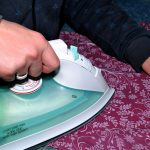Sewing machines are one of the most important tools for those who like to make things themselves at home. A sewing machine cover is a perfect way to keep your sewing machine clean and protected from dust. It can also look incredible and is fun and easy to make. Follow the instructions below to make your very own sewing machine cover.
What you need
You will need to measure the height, length and width of your sewing machine to work out how much fabric you will need. Add two cm to your measurements to allow for a seam. You will roughly need 1 metre of fabric for the main cover. You need material for the two sides, front, back and top of the machine. If you wish to add pockets to either of the sides or the front of the cover, you will need to measure these parts, but roughly a 25cm piece of fabric will do. You can use different patterned fabrics for the pockets and the main cover to create a nice contrast and make your cover look even better.
- You can use cotton for the fabric, or for a more durable cover use denim, vinyl or canvas.
You will need a few tools to put your cover together:
- Cotton thread – colour of your choice
- 1 metre of medium interface – you could also use fleece material for the lining if you wish.
- 2.5m of bias binding (25mm thickness)
- A ruler
- Scissors – a sharp pair
- Pins or wonder clips for tacking the material
- And of course, a sewing machine!
How to make
- Ensure that you have measured your fabric and have a piece for the front and back, the sides, the top and pockets (don’t forget the extra 2 cm for each piece to allow for the seam)
- Pin the cut pieces of fabric to the interface and roughly cut around each of the pieces.
- Set the sewing machine to the zigzag stitch and stitch the pieces carefully around the edge to the interfaces. Once you have finished, cut off any excess interface.
- Sew bias binding to the top edge of the pockets.
- Now to put the sides to the top piece. Pin the sides to the width of the top piece of fabric. Next, sew them, ensuring there is 1cm that is not sewn together.
- Depending on if you are having pockets at just one end or both, take the piece of fabric to be used for the pocket and pin it at the bottom of the side piece. Then sew down each side of the pocket, making sure you don’t completely sew all sides of the pocket, just the sides and bottom! Repeat on the other side piece for another pocket.
- Now to put the rest of the pieces together. Use the pins to place the back piece to the sides and top then sew together (have the materials facing the wrong sides for sewing together). Then, pin and sew the front piece on.
- To finish the cover, sew bias binding around the bottom edge of the cover. This will create a pretty edge and tidy finish for your cover.
- If you wish, you can create a slit for a handle so that you can carry your machine around with the cover still on. Work out where the handle is while still on the machine and mark it. Cut a piece of rectangle shaped fabric slightly bigger than the handle dimensions by about 2.5cm. On the wrong side of the cut out rectangle piece of fabric, mark the line where you will be cutting the opening and a stitching line roughly between 6-12mm from the cutting line. Place the fabric, the right side up lining the cutting lines with the marks made on the cover. Sew along the stitching line, starting at the centre of the rectangle sewing all the way around the rectangle. Cut along the cutting line stopping roughly 6mm from the end where you need to cut at an angle towards the corners of the rectangle. Turn the fabric to the insides of the cover then stitch around the opening.
You could make your cover even more interesting by using different pieces of fabric for each side, a perfect way to use up scraps of fabric that you have lying around! A pillowcase is a perfect piece of fabric to use and can be brought cheaply second hand. If you have a foot control, you may wish to add a larger pocket at the front to store this in. Simply measure the front not forgetting the extra 2cm for the seam and work out how big you want your pocket. Add binding to the top of the pocket, pin and sew to your machine cover. The side pockets are perfect for storing sewing essentials such as scissors and tape measures.

